Saarburg. A juicy, delicious, wine-soaked secret that Germany has been hiding up its sleeve. We’re all familiar with the big hitters, right? Berlin’s gritty cool, Munich’s beer-fuelled bravado, the fairytale castles of Bavaria. But what if I told you there was a place that felt like it had been plucked from a storybook and given a shot of adrenaline? Then add in a thundering waterfall just for the sheer, glorious drama of it all.
Saarburg. Honestly, I’d barely heard of it either. Tucked away in the wine-drenched hills of the Rhineland-Palatinate, not far from the Luxembourg border. It sits on the banks of the River Saar, a beautiful but often overlooked cousin of the mighty Mosel. We were staying at the Eurocamp just down the road (and up the mountain!) at Landal Warsberg. We decided to take a detour. Best. Decision. Ever.
We parked the car and wandered towards what we thought was the town centre. And then we heard it. A low, constant rumble. Not traffic. Not construction. It was the sound of water, and lots of it. We followed the noise, rounded a corner of half-timbered buildings, and then just stopped, mouths agape.

There, right in the beating heart of the town, was a 20-metre (that’s over 60 feet, folks) waterfall. Crashing down between cafes and boutiques. It wasn’t in a park, or on the outskirts. It was the centrepiece. The main event. The town’s living room fireplace. Except it was a torrent of raging water. An old, moss-covered mill wheel sat stoically beside it, a relic of the industry it once powered. It was completely, utterly, brilliantly bonkers. And I was already in love.
The Main Attraction: That Thundering Cascade
You can’t talk about Saarburg without starting with the waterfall. The Leukbach stream, a modest little river, was diverted through the town back in the 13th century to help power mills for tanners and grain grinders. A clever bit of medieval engineering, for sure. But what they created was pure, accidental theatre.
The water cascades down a series of rocky tiers, sending a fine, cooling mist over the terraces of the surrounding cafes. This isn’t some sanitised, fenced-off tourist attraction. This is a living, breathing part of the town. You can sit at a little iron table, a slice of apple strudel in front of you, and feel the spray on your face. The roar becomes a constant, comforting background noise, a white-noise machine for the soul.
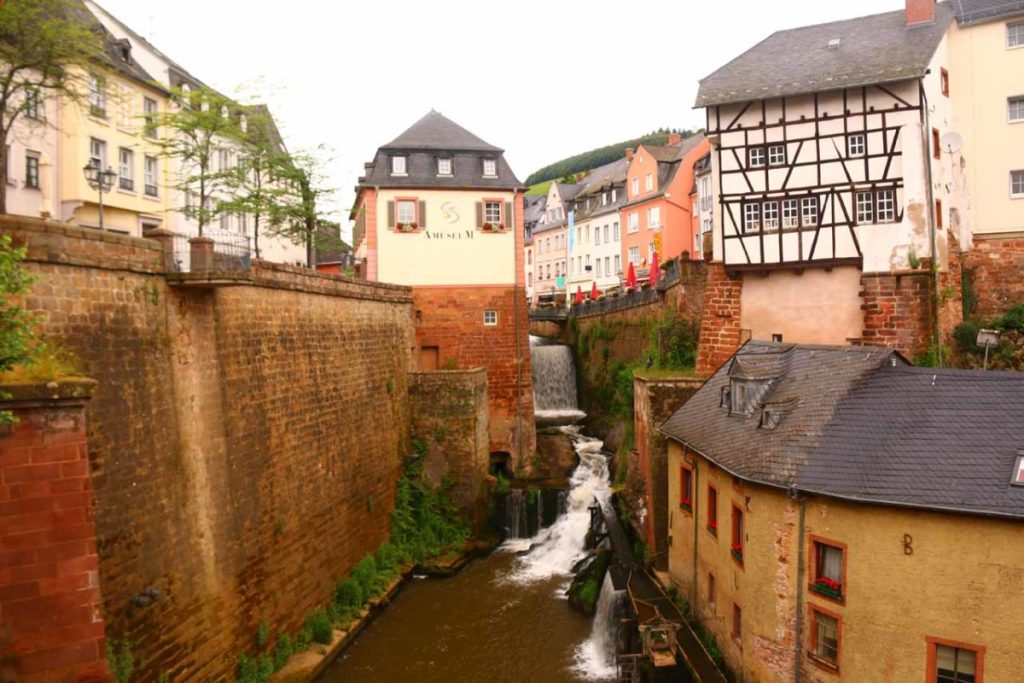 We spent our first hour just… staring. We crossed the little stone bridges that span the channel just above and below the falls, mesmerised by the sheer power of it. The area at the bottom of the falls, where the water churns before calming down, is known as the Buttermarkt (Butter Market). It’s here you’ll find the highest concentration of “I can’t believe this is real” photo opportunities. The combination of the crashing water, the ancient mill, and the pastel-coloured buildings clinging to the rockface is just sublime.
We spent our first hour just… staring. We crossed the little stone bridges that span the channel just above and below the falls, mesmerised by the sheer power of it. The area at the bottom of the falls, where the water churns before calming down, is known as the Buttermarkt (Butter Market). It’s here you’ll find the highest concentration of “I can’t believe this is real” photo opportunities. The combination of the crashing water, the ancient mill, and the pastel-coloured buildings clinging to the rockface is just sublime.
Little Venice? You bet.
From the Buttermarkt, the now-tamed Leukbach flows gently through a channel flanked by two rows of the most picturesque houses you’ve ever seen. This, my friends, is Saarburg’s “Klein Venedig” or Little Venice. And while that nickname gets thrown around a lot in Europe, here it actually fits.
Stone bridges arch over the water. Flower boxes explode with red geraniums, trailing down towards the stream. The houses, a mix of half-timbered and solid stone. Looking like they’ve been there forever, leaning on each other for support. On this sunny day, with the reflections shimmering on the water and people sitting outside wine bars with a glass of crisp, local Riesling, it’s about as idyllic as it gets. It’s Venice without the crowds. Without the cruise ships, or the €15 price tag for a cappuccino. It’s better. It’s real.
Let’s Get to the Important Stuff: The Food & Drink
Okay, scenery is great. Waterfalls are impressive. But you’re here at travelfoodandbooze.com, and you know what really gets our hearts racing. Let’s talk about what you’ll be stuffing your face with and washing it all down.
The Wine: Bow Down to King Riesling
First things first: you are in Saar wine country. This isn’t just a wine region; it’s one of the most revered on the planet for Riesling. The vineyards cling to ridiculously steep, slate-covered slopes that plunge down to the river. This unique terroir gives the wines a character you won’t find anywhere else.
 Saar Riesling is all about minerality, laser-sharp acidity, and delicate floral or green apple notes. It’s not the super-sweet stuff your nan used to drink. We’re talking elegant, complex, and dangerously drinkable wines. The word you’ll hear a lot is “racy.” It’s a wine that feels alive in your mouth.
Saar Riesling is all about minerality, laser-sharp acidity, and delicate floral or green apple notes. It’s not the super-sweet stuff your nan used to drink. We’re talking elegant, complex, and dangerously drinkable wines. The word you’ll hear a lot is “racy.” It’s a wine that feels alive in your mouth.
You’ll find it everywhere, from dedicated Weinstuben (wine taverns) to the simplest cafe. Don’t be afraid to ask for a recommendation. A great place to start is with a trocken (dry) or feinherb (off-dry) Riesling. It’s the perfect aperitif and cuts beautifully through rich food.
If you’re a real wine nerd, you’re in heaven. World-famous estates like Egon Müller and Van Volxem are just a stone’s throw away from Saarburg. While visiting the top-tier producers can require an appointment, many smaller, family-run wineries have tasting rooms that are more than happy to welcome you in. Our strategy? We found a local wine shop, told the owner our budget and what we liked. After an enjoyable sampling we walked out with three spectacular bottles we’d never heard of for less than €40. We drank one that evening on our balcony, overlooking the vineyards. Perfection.
The Food: Hearty, Honest, and Oh-So-Good
German food gets a bad rap sometimes. It’s often dismissed as just sausages and potatoes. And while, yes, they do both of those things exceptionally well, there’s so much more to it. The food in Saarburg is hearty, comforting, and designed to be eaten with a glass of wine in hand.
Here’s your must-eat checklist for Saarburg.
 Flammkuchen
Flammkuchen
Think of it as Germany’s answer to pizza, but more elegant. It’s a super-thin, crispy flatbread, traditionally topped with crème fraîche, smoky bacon lardons, and thinly sliced onions. It comes out blistered from a hot oven and is pure, unadulterated joy. It’s light enough that you can convince yourself it’s a snack, but satisfying enough for a full meal. Perfect for sharing. Or not. We didn’t.
 Schnitzel
Schnitzel
You can’t go to Germany and not have a proper schnitzel. We’re not talking about some sad, grey, breaded puck. We’re talking about a huge escalope of pork or veal, pounded thin, coated in breadcrumbs, and fried to a perfect golden-brown. It should be so big it hangs off the sides of your plate. Served with a wedge of lemon to squeeze over the top and a side of Bratkartoffeln (pan-fried potatoes with bacon and onion), it’s a masterpiece of simple cooking.
 Käsespätzle
Käsespätzle
If you need a hug in a bowl, this is it. It’s Germany’s version of mac and cheese, but on another level. Spätzle are tiny, soft egg dumplings, somewhere between pasta and gnocchi. They’re layered with heaps of grated cheese (often Emmental or Gruyère) and baked until gooey, then topped with crispy fried onions. It’s rich, decadent, and the ultimate comfort food after a long day of sightseeing (or wine tasting).
 Kaffee und Kuchen
Kaffee und Kuchen
The afternoon “coffee and cake” ritual is a sacred German tradition, and you should absolutely partake. Every bakery and cafe will have a bewildering display of cakes and tortes. From the classic Schwarzwälder Kirschtorte (Black Forest Gateau) to a simple but perfect Apfelstrudel with vanilla sauce, it’s impossible to go wrong. Grab a seat by the waterfall, order a coffee and a massive slab of cake, and just watch the world go by.
Working Off the Wine: What to Do When You’re Not Eating
Saarburg isn’t a massive place, but there’s plenty to keep you occupied between meals. And frankly, you’ll need the exercise.
Climb to the Saarburg Castle
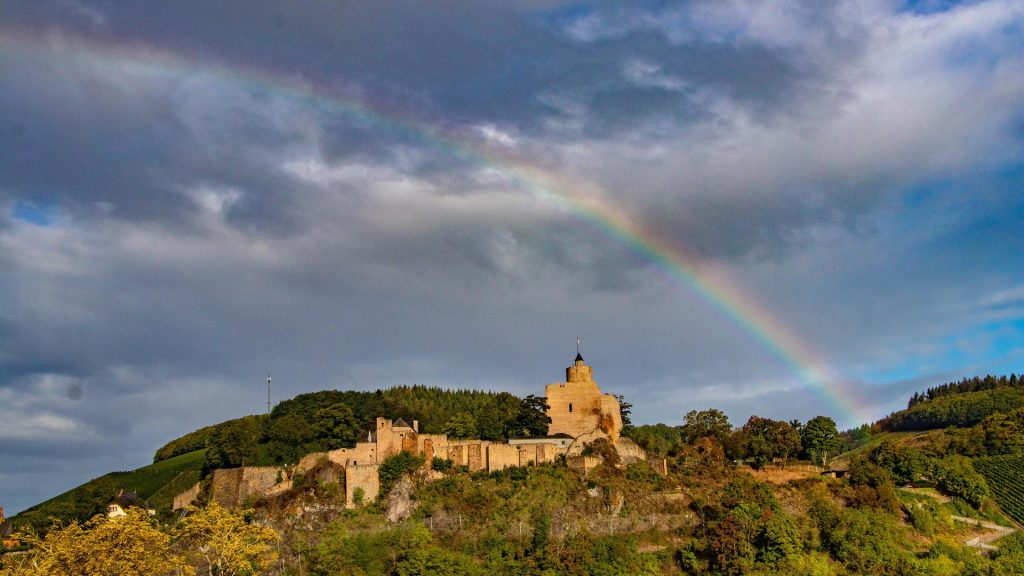 Looming above the town are the ruins of the Saarburg castle, which gives the town its name. Built way back in 964, it’s one of the oldest hilltop castles in western Germany. It’s a bit of a steep, calf-burning climb up through the winding streets of the old town, but my god, the payoff is worth it.
Looming above the town are the ruins of the Saarburg castle, which gives the town its name. Built way back in 964, it’s one of the oldest hilltop castles in western Germany. It’s a bit of a steep, calf-burning climb up through the winding streets of the old town, but my god, the payoff is worth it.
From the top of the remaining tower, you get the most incredible 360-degree panoramic view. You can see the entire town laid out below you, the Saar River snaking its way through the valley, and the endless, rolling hills blanketed in vineyards. It’s the perfect place to get your bearings and appreciate the sheer beauty of the landscape. It’s also the perfect spot to justify that second piece of cake later.
Float Over the Vines on the Sesselbahn
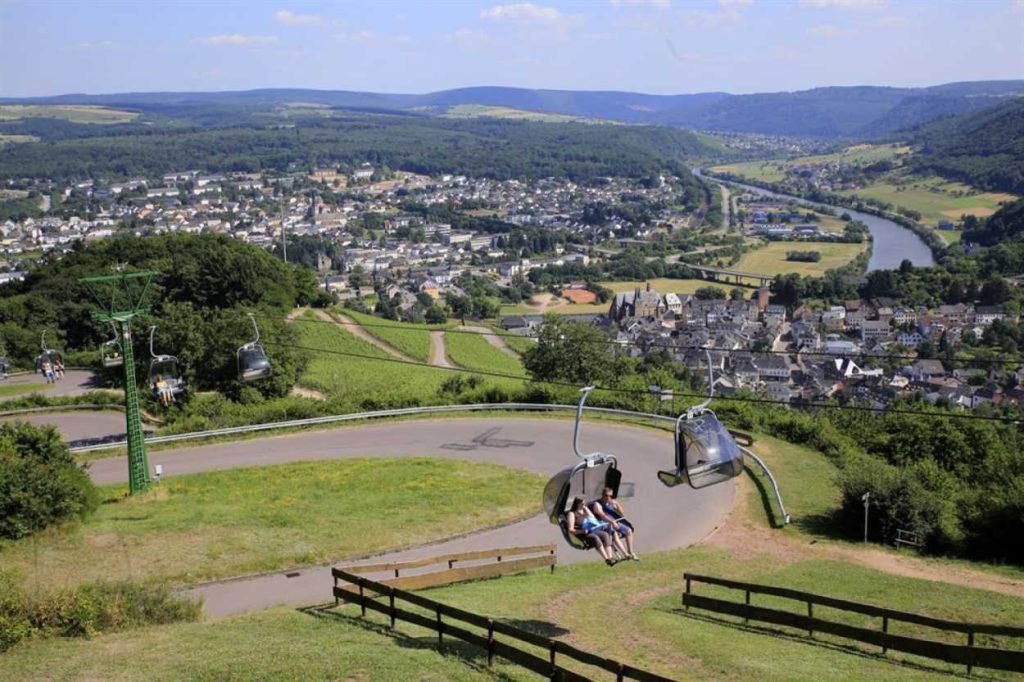 For a more leisurely way to get a great view, head to the Saarburg Sesselbahn, a classic two-seater chairlift. It starts in the town and gently carries you up the Warsberg mountain, right over the top of the steeply sloped vineyards.
For a more leisurely way to get a great view, head to the Saarburg Sesselbahn, a classic two-seater chairlift. It starts in the town and gently carries you up the Warsberg mountain, right over the top of the steeply sloped vineyards.
It’s a wonderfully serene experience. You float silently above the vines, watching the workers tend to the grapes. The valley stretching out below. At the top, there’s a café and, more importantly, a summer toboggan run! The ‘Saar-Rodel’ is a blast. You sit on a little sled and whizz down a metal track, controlling your own speed. It’s impossible not to giggle like a school kid the whole way down.
Get Cultured at the Amüseum
 If you get a rainy day or just need a break from the sun, the Amüseum is a surprisingly charming little museum located right by the waterfall. It’s housed in the former Electoral Mill and showcases the history of traditional crafts and trades in Saarburg and the surrounding area, from winemaking and tanning to printing and shoemaking. It’s a lovely, well-presented slice of local history that gives you a real appreciation for the town’s past.
If you get a rainy day or just need a break from the sun, the Amüseum is a surprisingly charming little museum located right by the waterfall. It’s housed in the former Electoral Mill and showcases the history of traditional crafts and trades in Saarburg and the surrounding area, from winemaking and tanning to printing and shoemaking. It’s a lovely, well-presented slice of local history that gives you a real appreciation for the town’s past.
The Practical Nitty-Gritty
- Getting There: Saarburg is easy to get to. It has a train station with good connections to major cities like Trier (just 20 minutes away and well worth a visit for its Roman ruins) and Saarbrücken. If you’re driving, it’s easily accessible, and having a car is great for exploring the wider wine region. The closest major airport is Luxembourg (LUX), about a 45-minute drive away.
- When to Go: We were in Saarburg in late summer, and it was glorious. The weather was warm, and the town was buzzing with life. Spring would be beautiful as everything comes into bloom. But I imagine autumn is the showstopper. The grape harvest season (Weinlese) would be in full swing, and the vineyard-covered hills would be a riot of gold and crimson.
- Where to Stay: There’s a good range of options. We stayed at the Eurocamp at the top of the Sesselbahn. You can find lovely family-run Gasthäuser right in the old town, some with views over Little Venice. There are also more modern hotels on the outskirts if you prefer.
Final Thoughts: Go. Just Go.
Saarburg is one of those rare finds. It’s a town with a unique, showstopping centrepiece that could so easily have made it a tacky tourist trap. But it isn’t. It’s retained its charm, its authenticity, and its laid-back, wine-loving soul.
It’s a place to slow down. To sit for two hours over lunch. To sample another glass of Riesling just because, to be mesmerised by the simple, constant power of water. It’s beautiful without being pretentious. Historic without being stuffy.
If you’re looking for a European getaway that’s a little off the beaten path. A place that perfectly balances stunning scenery with incredible food and world-class wine, then please, take my advice. Pack your bags, and your appetite, and get yourself to Saarburg. You can thank me later, preferably over a glass of something crisp and minerally. Cheers!


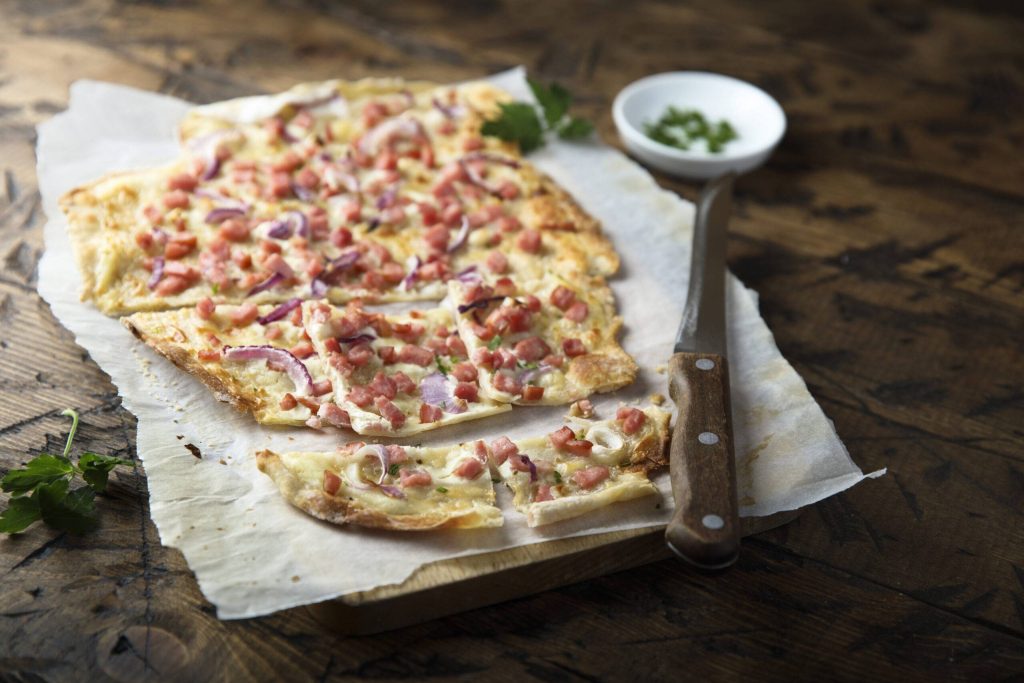 Flammkuchen
Flammkuchen Schnitzel
Schnitzel Käsespätzle
Käsespätzle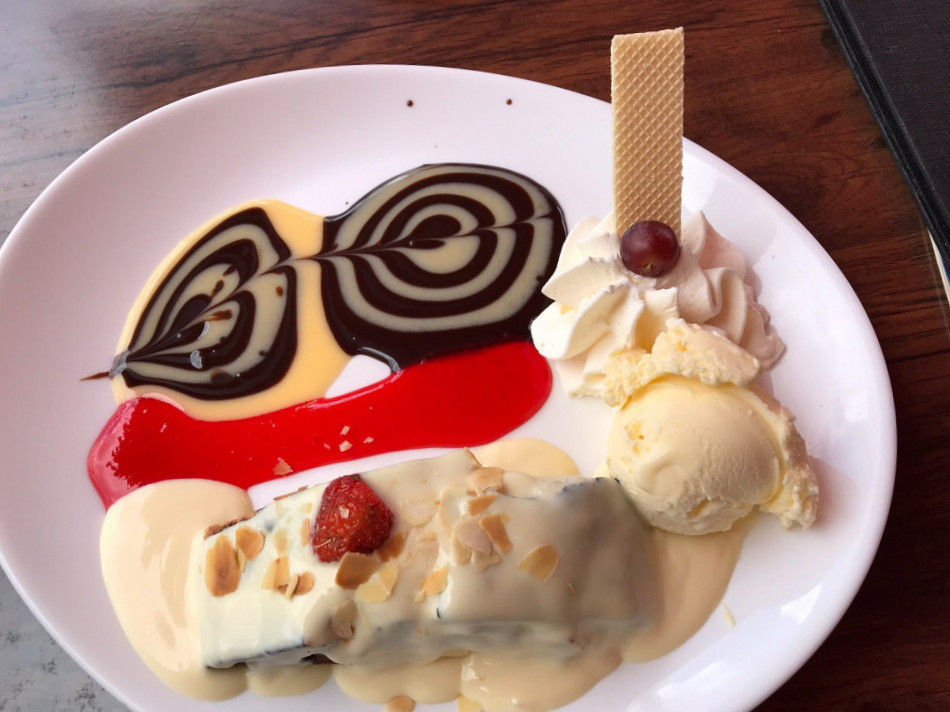 Kaffee und Kuchen
Kaffee und Kuchen